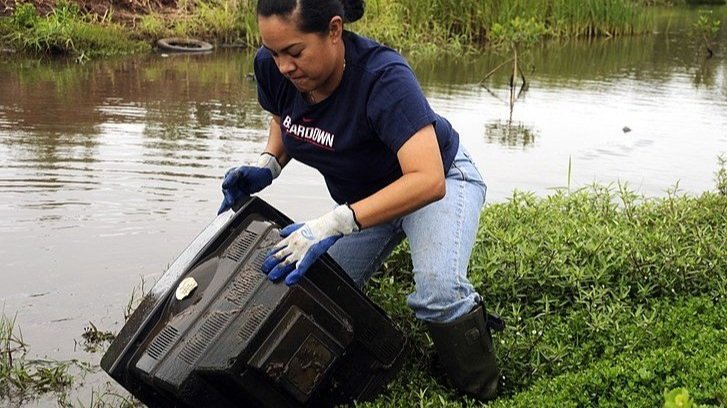Brookings pastor Carl Kline: A house can be a home to many people over the years, and that’s true of our nation as well
Our house was built in 1890. We were told when we purchased it in 1979, that it belonged to the first doctor in the community. He had an addition added sometime later to better accommodate his patients, as his office was in his home. It helps to explain two entries in the front of the house and two kitchen areas, one on each side of the first floor.
Apparently the house remained in his extended family after the doctor’s death, until some years later when it was purchased by the Catholic church across the street. They initially used it as a home for the Catholic sisters serving the congregation. (I used to tell our children when they were growing up that the strange musical sounds coming from our refrigerator were actually the sisters, now angels, playing their harps).
In 1975, our house became a home for refugees from Vietnam. The local Catholic church was one of those religious communities that stepped forward to welcome and accommodate the needs of those fleeing that war-torn country.
Church members donated whatever was needed to make the house a home.
When we arrived in 1979, the refugee crisis had ended and the house had been purchased by someone who intended to make it a duplex. The doorway from one side of the house to the other was now a wall. For several days we had to access the other side by going upstairs on one side and downstairs on the other, or going out one front door into the other.
We also found ourselves grateful for the annual Brookings Spring Clean-Up. The new owner had cleaned out the house and many of those refugee donations ended up in our shed and back yard. Most of the things stored in the shed we could move to the curb. But gratefully, the city workers came into the yard for the larger items, stoves and washing machines and all manner of appliances. I think we filled a truck!
This house has been a home for our family for 45 years. But it was only recently that I learned a little bit more about its history.
The doorbell rang. I wasn’t sure which door it came from so I first checked the door on the west. No one was there, so I went to the other door. As no one was there either, I stepped out on the porch to see if maybe it was a delivery.
I noticed a couple walking their dog, and as he turned and saw me, he came running across the yard toward me. Smiling and breathless, he introduced himself as a former resident of the house. His was a family of Vietnam refugees who lived in the house in 1975, when he was 7 years old.
As we shared stories about the giant dutch elm tree in the side yard, now long gone and replaced by a giant maple; the garden in the backyard; and how we both agreed it was an awful green paint on the exterior of the house in both 1975 and ‘79, I invited him inside and listened as he had remembrances to share when we walked from room to room.
His excitement was catching. It was a wonderful 30 minutes and a special new insight for me into the history of this 124-year-old home. It also made me consider more deeply the primary election issue facing our country today; immigration! So much is wrapped up in that issue: race and racism; labor issues and economics; Christian Nationalism and religious diversity; equality of the genders or patriarchy; gates or walls.
We have a choice to make! During President Trump’s years, legal immigration dropped to its lowest point in history. Restrictions were placed on immigration from: Iran, Iraq, Libya, Somalia, Sudan, Syria, Yemen, Venezuela, North Korea, Eritrea, Kyrgyzstan, Myanmar, Nigeria, Chad and Tanzania. Many were what he called shit-hole countries.
We also remember the Muslim ban. In Brookings, it meant dozens of SDSU students were afraid to go home as they would not be able to return. In the meantime, illegal immigration continued unabated, even with the wall.
Earlier this year a bipartisan bill was developed in Congress that President Biden was prepared to sign. It would have added both border and immigration personnel, critical to its efficient operation. It would have invested in technology to stop the entry of fentanyl. There were planned and sweeping reforms to the asylum system.
And the president would have been granted the authority to shut down the border when the system was overwhelmed. Republicans eventually rejected this effort, as Trump wanted immigration as a primary campaign issue for the 2024 election.
Our visitors now live in Portland, Ore., and were just in town for a day. He works for Nike and almost convinced me they have a shoe that would help me treat my sore heel. They left our house to walk down the alley, as he hoped to recognize the home where his best friend lived.
Like everyone else, I want a secure border. But I also want to see the sheer joy of remembrance in the face of an immigrant, a refugee, like on the face of my new friend. I want to feel their excitement again and again and again. I want to understand and celebrate their new life in this country.
As inscribed on “Lady Liberty” (seen above in a public domain image posted on wikimedia commons): “Give me your tired, your poor, your huddled masses yearning to breathe free …”
Carl Kline of Brookings is a United Church of Christ clergyman and adjunct faculty member at the Mt. Marty College campus in Watertown. He is a founder and on the planning committee of the Brookings Interfaith Council, co-founder of Nonviolent Alternatives, a small not-for-profit that, for 15 years, provided intercultural experiences with Lakota/Dakota people in the Northern Plains and brought conflict resolution and peer mediation programs to schools around the region. He was one of the early participants in the development of Peace Brigades International. Kline can be reached at carl@satyagrahainstitute.org. This column originally appeared in the Brookings Register.







